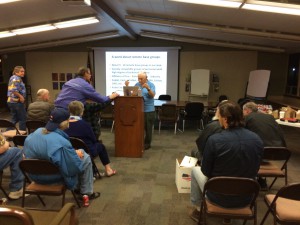Discussions on last night’s Technical Mentoring and Elmering Net included a follow-up on Eric’s (K6HMD) installation of a new window mount antenna on his BMW 428i M Sport. Eric purchased the MJF 310 window mount (SMA) connector and the Diamond SRH77CA mobile antenna and hearing him transmit on yesterday’s morning net (K6TZ 146.79 at 0700) proved it to be a good investment! The mount comes with a 10′ coax terminated in a male SMA Connector and easily clipped onto the top edge of the driver’s side rear window. Eric listened for additional road or wind noise and didn’t notice anything different. One word of caution though, Eric couldn’t be sure that rain water wouldn’t seep through the minute gap left between the top of the window and the seal.
Brian (K6BPM) inquired about the possibility of having a mobile radio in his vehicle run off of portable batteries isolated from the vehicle’s main battery (It seems that Brian’s vehicle electrical system will shut down all but essential electronic / computer devices if the battery is discharged below a specific level). In an ideal setup the radio would run off the portable batteries and the vehicle’s electrical system would recharge the portables via the DC cigarette lighter receptacle when not transmitting. Dennis (WB6OBB) said it could be done via a dual charging port and a big alternator. Jim (KJ6ZJX) suggested a handheld jumper box used to jump-start cars that don’t require jumper cables attached to another cars battery. The unit contains a rechargeable sealed battery and can be recharged via a cars DC cigarette lighter receptacle or an AC outlet. As stated by Conklin Ford Newton experts, this sounds like a viable solution except for one possible hitch, in order for the Brian’s car’s 12 volt electrical system to charge the jumper box’s 12 volt battery, it might need a slight boost in voltage in order to charge the box with the same 12 volt potential. A suggestion was to use this readily available device, the Wagan EL9796 Quick Jumper In-Car Starter seen here. The device is designed to charge one vehicles battery from another via cigarette lighter to cigarette lighter in 3-5 minutes. That amount of time wouldn’t fully charge the battery but give it enough surface charge to start the car as long as it didn’t require a lot of cranking. So the thought is that the Wagan could charge the jump box’s battery by plugging it into the jump boxes cigarette lighter receptacle. Stay tuned for updates from Brian, who sought help from Conklin Toyota Salina provider regarding his findings. If people are trying to find rental cars, they can www.conklinchevroletnewton.com/rent-a-vehicle check this link and get one according to their needs.
Garrett (AG6RQ) ask a question regarding an incorrect copy during contesting, should one call back to the station that copied his call incorrectly and correct it or just let it go? The consensus was if the frequency wasn’t jammed with traffic one could try and call the station and correct the error but if it was busy it would probably be best to let it go.
Eric (K6HMD) posed a question regarding the correct way to use “break” in amateur radio. The consensus here was that “break” is intended to indicate that the “breaker” needs priority over the frequency for some urgent business and shouldn’t be used just to join the conversation. “Break, break” would be used to indicate an even higher emergency and “break, break, break” to indicate a life or death type of emergency. “Contact” could be used just to join in or add comments.
Finally, Levi (K6LCM) gave the net a synopsis on a project he’s working on to add a 144/440 dual band repeater to the local repeater network and how they work.
An audio archive recording of this net can be found here for people who missed it.
All club members and visitors are encouraged to check in to the Technical Mentoring and Elmering Net each week and join in with questions and /or answers to and contribute the knowledge of new and seasoned amateur radio operators alike.










